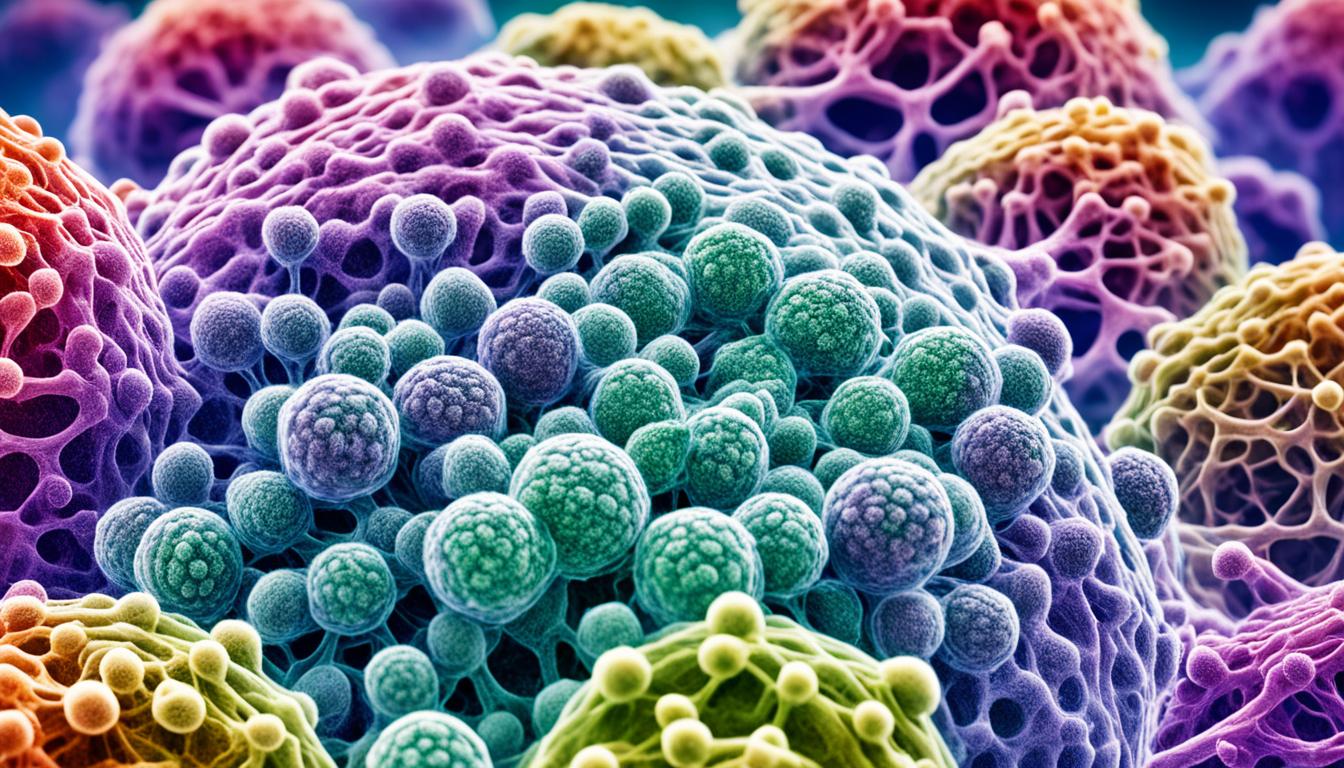Anthrax is a serious illness caused by the bacterium Bacillus Anthracis. Humans can get it from infected animals or their products. There are several types of anthrax, such as skin, lung, and stomach anthrax. Doctors use tests like blood cultures and PCRs to diagnose it.
Early treatment with antibiotics and supportive care is important. In some cases, patients may need antitoxins. Recently, scientists have been looking into using stem cells to treat anthrax. Their research shows it might be a good approach.
Key Takeaways:
- Anthrax is an acute infectious disease caused by Bacillus Anthracis.
- It can be transmitted to humans through contact with infected animals or contaminated animal products.
- The symptoms of anthrax vary depending on the form of the disease.
- Diagnosis involves specific tests such as blood culture, PCR, and serological testing.
- Prompt treatment with antibiotics, antitoxins, and supportive care is crucial.
- Stem cell therapy shows promise as a potential treatment option for anthrax.
Symptoms of Anthrax
Anthrax comes in different types, each with its own set of symptoms. Here’s what to look out for:
- Cutaneous Anthrax:
– A painless ulcer develops
– There’s swelling around it
– A black scab forms - Respiratory Anthrax:
– You may have a severe infection-toxin syndrome
– Chest pain could occur
– You might find it hard to breathe
– And pneumonia can set in - Gastrointestinal Anthrax:
– It often starts with stomach pain
– You might vomit
– Have bloody stools
– And pass mucus
On top of these, all types of anthrax can cause high fever, tiredness, headaches, and swollen lymph nodes.
Remember, symptoms differ in each person. If you suspect anthrax, get medical help right away. Early treatment is key.
Causes of Anthrax
Anthrax comes from the Bacillus anthracis bacterium. It’s a spore-forming bacteria that likes soil. It mainly affects animals like cows, sheep, and goats [1]. People can get anthrax from touching infected animals or their products. Jobs like farming, animal care, or slaughter work put you at higher risk [2].
These bacteria’s spores can hang around for a long time. They are harmful to health. Touching spores or breathing them in can infect you. Eating bad meat or products can also cause outbreaks [3].
Anthrax isn’t easily spread from person to person. Very few cases have been found where people got it from someone else, especially the kind you breathe in. But overall, getting anthrax this way is not something to worry a lot about [4].
Preventing Anthrax Transmission
Stop the spread of anthrax by handling and getting rid of dead animals properly. Clean up and disinfect areas where you find the bacteria. Use the right equipment to protect yourself in at-risk jobs [5]. If your job is risky, get vaccinated. Also, after being close to an anthrax case, you might get antibiotics to be safe [6].
Occupations at Risk of Anthrax Exposure
| Occupation | Risk Level |
|---|---|
| Farmers and agricultural workers | High |
| Veterinarians and animal healthcare professionals | High |
| Workers in abattoirs and slaughterhouses | High |
| Tannery workers | High |
| Laboratory personnel handling anthrax cultures | High |
| Herbivorous livestock handlers | Moderate |
| Leather workers | Moderate |
Good hygiene and safety measures really lower your anthrax risk. This helps keep you and your community safe.
References:
- Treatment of anthrax: antibiotics and vaccines. U.S. National Library of Medicine.
- Anthrax. Centers for Disease Control and Prevention.
- Human Anthrax Associated with an Epizootic Among Livestock – North Dakota, 2000. Centers for Disease Control and Prevention.
- Anthrax Q&A: Disease, Prevention, and Treatment. U.S. Food and Drug Administration.
- Prevention and control of anthrax in an endemic area. World Health Organization.
- Post-Exposure Prophylaxis (PEP) for Anthrax. Centers for Disease Control and Prevention.
Diagnosis of Anthrax
Diagnosing anthrax combines clinical exams, patient history, and lab tests. It’s key to start treatment quickly and prevent the disease from spreading.
Doctors look at symptoms, medical past, and any contact with infected animals. This helps narrow down the diagnosis.
Tests like blood cultures detect the anthrax bacteria.
Blood Culture:
A blood culture is done before giving antibiotics. It looks for Bacillus anthracis in the blood, confirming anthrax.
PCR (Polymerase Chain Reaction):
PCR finds the bacterial DNA in body fluids or tissues fast. This method is very accurate, spotting anthrax early.
Serological Testing:
Testing blood serum for antibodies shows exposure to Bacillus anthracis. It’s especially helpful in late-stage or atypical cases.
Other tests like Gram stains and cultures may also be used. They help confirm Bacillus anthracis in different samples.
For each form of anthrax, like skin, lung, or stomach, specific tests may be needed. This could include tests on fluids from the lungs or stomach.
Getting an early, correct diagnosis of anthrax is critical. It stops the disease from getting worse and speeds up the right treatment. This improves the patient’s chances of recovery.
Treatment of Anthrax
Quick and right treatment is key in handling anthrax infections. Using antibiotics, antitoxins, and supportive care together is vital.
Antibiotics
Antibiotics are crucial in treating anthrax. They are given through IV. Doctors often prescribe penicillin, ciprofloxacin, and doxycycline. These drugs fight the anthrax bacterium, Bacillus anthracis, which causes the infection.
Antitoxins
Antitoxins are used to stop toxins from Bacillus anthracis. Raxibacumab and anthrax immune globulin are common antitoxins. They work against the toxins, helping the body recover.
Supportive Care
Supportive care is critical for severe anthrax cases. It includes keeping the patient hydrated and using meds to keep their heart and blood pressure in check. This care is personalized and can boost the patient’s chances of getting better.
Adjuvant Glucocorticoids
Sometimes, adding glucocorticoids to the treatment can help. Prednisone is an example. These drugs lower swelling and help control the immune system’s response. This could make a difference in how well the infection is fought.
With the right treatment, anthrax recovery can be good. It’s important to get help fast if you think you have anthrax. Quick treatment increases the chance of a full recovery.
Prevention of Anthrax
Prevention is key to lowering the danger of anthrax spreading. By following strict rules, we can keep people safe from this infection. It’s important to focus on a few key ways to prevent anthrax:
Animal Quarantine
Setting up a strong animal quarantine helps stop the anthrax spread. Sick animals should be kept away from others. This step is crucial and involves watching over animals with anthrax contact closely. It also means not letting them go to new places. Plus, we need to take steps to keep them healthy and keep the disease from spreading.
Proper Disposal of Infected Carcasses
Getting rid of dead animals from anthrax correctly is important. We have to do this quickly and without risk. Methods include burying them, burning them, or using special places to dispose of them.
Thorough Disinfection of Contaminated Areas
Places where anthrax is found, like farms and labs, need to be cleaned well. Cleaning must be complete to kill the anthrax germ. This work includes cleaning surfaces, tools, and even clothes to make sure the sickness doesn’t spread.
Vaccination
Vaccines are crucial, especially for those at high risk of anthrax. The BioThrax vaccine is good for people working with anthrax, like those in labs or slaughterhouses. A shot can stop them from getting sick.
Post-exposure Prophylaxis
After close contact with anthrax, some people may need to take antibiotics. Medicines like ciprofloxacin or doxycycline can stop anthrax from growing. This needs to be done quickly to prevent spreading the sickness.
To fight anthrax, we need to be very careful. By doing things like keeping animals away, disposing of dead ones safely, and cleaning places well, we can stop anthrax from hurting people. Vaccines and quick treatment with antibiotics also play a big role in keeping us safe from this disease.
Stem Cell Therapy for Anthrax
Stem cell therapy is very promising in fighting anthrax. Studies suggest that mesenchymal stem cells (MSCs) can help the body fight the disease. They also encourage the body to heal itself, opening new ways to fight anthrax.
Tests on animals with anthrax have had good results. MSCs improved survival and reduced damage to organs. They can become different types of cells, like those that fight off infections or suppress harmful inflammation. Plus, MSCs release substances that help damaged tissues heal.
Still, there’s much to learn about using stem cells for anthrax. Researchers are working to find out the best dosages and when to give the treatment. They need more tests to understand how safe and how well it works in the long run.
Doctors and scientists hope that by using stem cells, they can boost the healing of anthrax patients. This ongoing research might lead to better ways of treating the disease. It could mean improved care for those with anthrax down the road.
Epidemiology of Anthrax
Anthrax is found worldwide, causing outbreaks everywhere. While it affects people rarely, it is risky for those working with animals or their products. Even animals can get anthrax, putting humans at risk through contact. It is critical to watch for it, diagnose it, and treat it fast to stop its spread.
Key Points:
- Anthrax is a common disease that has sporadic outbreaks globally.
- Working with animals or their products raises the risk of getting anthrax for humans.
- People can catch anthrax from infected animals through close contact.
- Monitoring and identifying outbreaks early with surveillance is crucial.
- Swift diagnosis and treatment help prevent anthrax from spreading.
Understanding anthrax’s spread means looking at how it shows up in different places and groups. It can appear in places all over the globe, with symptoms varying in number and severity.
In some places, like rural areas, being near animals can mean a higher risk of getting anthrax. People who handle animals or their products, including farmers, vets, and slaughterhouse workers, face a higher chance of catching it.
Animals like cattle, sheep, and goats can pass anthrax to us with close contact or by eating their infected parts. So, it’s important to avoid touching sick animals or eating their products.
HTag: Effective surveillance keeps an eye on anthrax and helps find its sources. Quick diagnosis and case reports are key to stopping the spread and taking preventive steps.
Stopping anthrax outbreaks needs many steps, like vaccinating those most at risk, such as slaughterhouse or lab workers. Others close to anthrax cases may need antibiotics to protect them.
Knowing about anthrax and taking the right steps to prevent it helps keep us safe.

Conclusion
Anthrax is a deadly disease caused by the bacterium Bacillus anthracis. You can catch it from infected animals or their products. It comes in different forms, each with its own unique symptoms. Early diagnosis is key. It allows doctors to start treatment quickly with antibiotics and the right supportive care.
There’s a new area of hope in fighting anthrax called stem cell therapy. Research in labs has shown that these mesenchymal stem cells (MSCs) can help. They seem to improve the immune system and help damaged tissue heal.
But, we need more study to understand exactly how to use stem cells in treating anthrax. For now, we should put a lot of effort into prevention. This means keeping animals away until they’re safe, handling dead animals right, and cleaning up well. Also, make sure people who are more likely to get anthrax, like those who work with animals or in labs, are vaccinated.
Through these steps and by researching stem cell therapy more, we can fight anthrax better. We aim to make its spread less and keep people safe and healthy.

